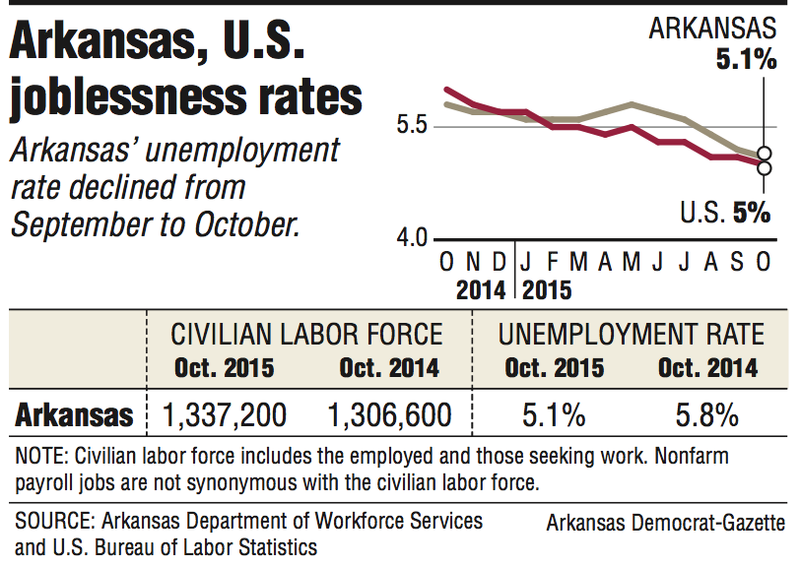Arkansas' unemployment rate dropped for the fifth-straight month in October, mirroring a decline in the national rate, the U.S. Bureau of Labor Statistics said Friday.
The unemployment rate fell to 5.1 percent, down from 5.8 percent in October 2014. The national rate was 5 percent in October.
Arkansas is now seeing monthly increases in employment and in the labor force, said Kathy Deck, director of the Center for Business and Economic Research at the University of Arkansas at Fayetteville.
In the years right after the recession -- that ended in 2009 -- the state's labor force and the number of employed Arkansans declined most months.
"It's positive all the way around now," Deck said. "All the components of the unemployment rate are moving in the right direction."
The state's labor force grew 2.1 percent in the past 12 months to 1.34 million in October.
"That's very, very healthy," Deck said. "We haven't seen the labor force this large since 2009 and 2010."
The state's unemployment rate still has room to fall, Deck said.
From January 1999 to June 2001, Arkansas' unemployment rate was below 5 percent every month. It settled at its lowest level -- 4.2 percent -- from April 2000 to September 2000.
"When you see an unemployment rate as low as it is now, you don't expect it to go much lower," Deck said. "But as long as the national rate keeps going down, there is an opportunity for it to go several tenths of a percentage point lower."
Seven job sectors grew over the past year and four fell. The total number of nonfarm payroll jobs was up 19,700 in the past year, the Bureau of Labor Statistics said.
"This was another month of relatively good numbers, at least when it comes to the service sector," said Michael Pakko, chief economist at the Institute for Economic Advancement at the University of Arkansas at Little Rock.
The number of service jobs has risen by 16,100 in the past year and 8,200 construction jobs have been added to the workforce since October 2014.
"The construction figures continue to be pretty remarkable," Pakko said.
Northwest Arkansas is seeing a resurgence in both residential and commercial development, Pakko said. There also has been significant apartment construction in central Arkansas, Pakko said.
"And, anecdotally, I think a notable share of the increase in construction activity is associated with the Big River Steel plant [near Osceola]," Pakko said.
Work began on the $1.3 billion steel mill began last year and is scheduled to be completed next year.
The state saw a big increase in construction permits last year, said Marc Fusaro, associate professor of economics at Arkansas Tech University. Arkansas Tech conducts a monthly survey of 18 cities in Arkansas, tracking several economic indicators.
"We are seeing the fruits of that in the 2015 construction," Fusaro said. "But commercial construction permits are down for 2015 year to date."
The number of manufacturing jobs in Arkansas continues to decline. There were 153,000 manufacturing jobs in October, down 3,900 from a year ago.
"There were a few months earlier this year where it looked like we might have a bounce-back in manufacturing," Pakko said. "But that seems to have tapered off again. We're really not seeing any lasting, significant growth there."
Two job categories -- the professional and business services sector and the educational and health services sector -- have rebounded since the recession ended, said Greg Kaza, executive director of the Arkansas Policy Foundation in Little Rock.
There were 180,500 jobs in the educational and health services sector in October, up 5,400 jobs in the past year.
Professional and business services accounted for 140,800 jobs last month, just 100 below the peak in September and an increase of 4,400 jobs in the past year.
Overall, the two sectors tend to be filled with white-collar, higher-paying jobs, Kaza said.
Nationally, North Dakota reported the lowest unemployment rate at 2.8 percent, followed by Nebraska at 2.9 percent, South Dakota at 3.2 percent and Hawaii and New Hampshire at 3.3 percent each.
West Virginia had the highest unemployment rate -- 6.9 percent -- followed by New Mexico at 6.8 percent, Nevada's 6.6 percent, Alaska's 6.4 percent, and Louisiana at 6.2 percent.
In October, 32 states had declines in their unemployment rates compared with September; three reported increases and 15 had no change.
Business on 11/21/2015
